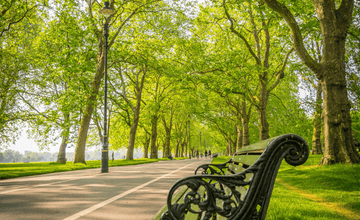Blog
London Pollen Count
by
Kate Young
on
Dec 28, 2022
Despite the skyscrapers in London, there are over 9200 hectares of gardens and parks across the city, making it the greenest city in Europe. Even though this is excellent news for the local ecosystem and those who love picnics, it also means that the pollen count in London can hit some big highs. The most common culprit for London's hay fever is the London plane, the most common tree lining the streets and multiple parks.
What is pollen count?
Pollen count can be measured through the average number of pollen grains per cubic metre. A pollen count is usually recorded during the day, so when reading pollen count forecasts, you should know they likely reflect daytime figures. To measure pollen count, the rotarod technique is used. This technique uses greased silicone rods to collect particles from the air for 24 hours. There are other devices capable of collecting data for several days.
When the pollen count is 50 or below, it is considered low. However, a pollen count of 1000 or more is deemed very high. The measurements used here can differ depending on the type of pollen. Pollen count can highly determine your symptoms' severity if you have hay fever. When the pollen count is high, you will know through your allergies as they will be at their worst. You should take measures such as closing your windows and doors during these times. Pollen counts go up and down during different seasons and even during the day.
What time of the day is the pollen count high in London?
The pollen amount in the air varies from day to day as well as throughout the day. Pollen counts start rising in the morning and reach their peak midday or early afternoon. Your allergies may be at their worst during midday or early afternoon since the air is highly concentrated with pollen. The quantity of pollen in the air and how it affects you also depends on the pollen you're allergic to. Because if you're allergic to tree pollen, you will notice your symptoms peak at different times of the day and even year. If you see a change in the time of day your pollen allergy symptoms peak, you should talk to your doctor. This could mean that another allergen is the source.
So, since pollen count rises in the morning and peaks at around midday, it starts going down, and pollen counts are usually low before dawn, in the late afternoon and early evening. If the pollen count forecast for the day is high, it will take a bit of time because these levels go down, and it may leave a high concentration of pollen in the air. In general, pollen counts are often low at night. When you have cool nights, it may cause pollen to descend to the second story or ground level. When you know your pollen peak season helps you better manage the symptoms.
The pollen count in London by season
Different types of pollen show up during other times of the year. We'll see when you should expect a specific pollen to be in the air.
Spring
In March, April and May, you should expect weed pollen, tree pollen, and grass pollen. Tree and grass pollen have peaks in these months, which may worsen your allergies resulting in painful sinuses and a cough.
Summer
In June, July, and August, grass and weed pollen peak. This brings about a dominance of symptoms like watery and itchy eyes, which could be much worse, especially when you're going outside.
Autumn
In autumn, hay fever reduces since pollen season declines at the beginning of September.
Winter
Since pollen season begins as early as January, hay fever symptoms like sore throat, runny nose, blocked nose, cough, and itchy and watery eyes are often mistaken as cold or flu symptoms.
How do temperature and weather affect pollen count in London?
Pollen counts are highest when it's dry and windy. So, you'll find your hay fever symptoms severe on such days. The wind stirs up pollen into the air, keeping pollen counts high. Alternatively, rain lowers airborne pollen no matter the time of day. If you still want to go out during high pollen count seasons, you need to time it with a sun shower, which means you should be ready to get a little bit wet.
How to manage high pollen counts
When pollen counts are high, you need to find ways to manage them. These include:
- Check for local pollen count predictions, which could help you better prepare for your days. Some various apps and websites will help you see the pollen count in your area upon putting your location.
- Don't allow pollen into your home. You should keep your windows closed on even warm nights to prevent pollen from getting in and prevent you from having a good night's sleep.
- Take antihistamines to avoid symptoms of hay fever.
- Avoid outdoor activities around midday if possible. This is especially necessary for those with asthma. You need to forgo outdoor activities when pollen counts are high, as they may aggravate asthma.

Our Allergy Test Box Kit
Pollen allergy testing
Knowing which types of pollen you are allergic to is crucial as it helps you better manage them during the pollen season. An
Allergy Test will help you determine all your allergies, whether in food, your environment, or even drinks. By taking this home for a lab test, you will figure out which pollen you're allergic to and find ways to manage them. When you know your allergies, it gets easier to narrow down the seasons when you'll have the worst hay fever symptoms and figure out a way around them, making your life easier.
 Our Allergy Test Box Kit
Our Allergy Test Box Kit











